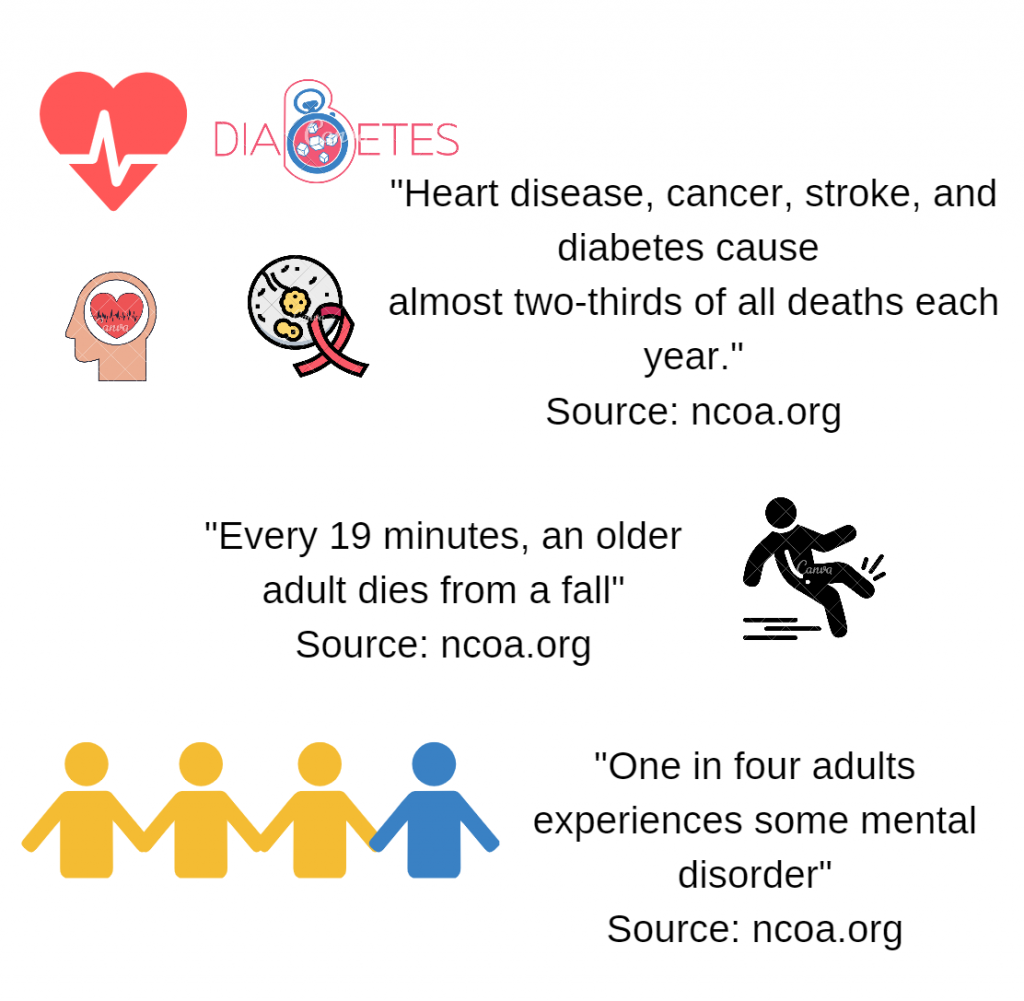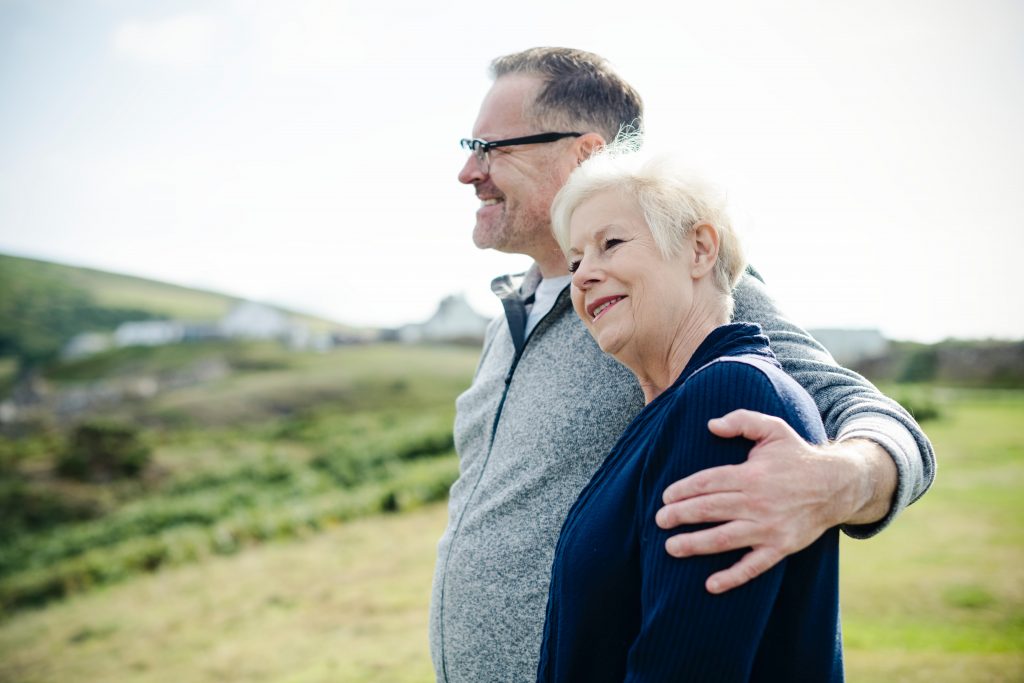
At Senior Care Center, our advisors are happy to help answer every question families may have about finding the right home for their senior loved ones. We know the challenging process of going from home to home in order to find the perfect place where your loved ones will thrive. Our customers often come to us to ask for advice about their family situation and the questions that comes up the most is, “Am I the only one who is dealing with this?” The truth is, millions of families across America are in similar shoes. One of the ways Senior Care Center can help you and your family is by sharing information, knowledge, and expertise that would be helpful to you in your decision process. As you search for the right place for your senior loved one, here are some statistics about the senior population to be aware of.
Aging populations in U.S. society
How many seniors are there?
The senior community makes up a large portion of American society, with millions of elderly and older adults facing similar challenges exclusive to their community. According the US Census Bureau, there are currently over 51 million people over the age of 65, making up about 15% of the population in the US. With such a large number of people, there is no doubt that each of us know someone who faces the challenges of the aging population.
Where do seniors live?
According to the US Census Bureau’s 2016 American Community Survey, Florida has the highest rate of residential seniors; about 19.9% of the population is 65 years and older. Maine comes in second with seniors making up 19.3% of the population.
How many seniors are in the workplace?
In a time where older Americans are prone to age discrimination, disability, and chronic health conditions, there are questions concerning the number of seniors who make up an active workforce.
Nearly one out of six elderly Americans are still involved in the workforce, about 9.1 million people. In Alaska, 25.9% of seniors who are aged 65 and older are still participating in the work force, the highest percentage amongst the 50 states.
Senior disability
Disability amongst the population increases as the age increases. Senior disability is a common reason why many seniors are unable to continue working. In states such as Oklahoma, about 43% of the senior population suffers from one or more disabilities pertaining to cognition, hearing, eyesight, walking, self-maintenance, and completing errands.
Population projections for the future
In the US Census Bureau’s 2017 National Population Projection for the year 2035, the projected percentage of older adults (65 years and older) surpassed the projected number of children under 18, and historic first in US population projections. In the year 2060, the number of seniors above the age of 65 is projected to be 98 million people.
Senior health and senior care services
According to CDC National Health Center’s 2016 report on long-term care providers and services in the US, there were an estimated 4,600 adult day services centers, 12,200 home health agencies, 4,300 hospices, 15,600 nursing homes, and 28,900 residential care communities.
The leading causes of death for seniors 65 years and older are heart disease, cancer, and chronic lower respiratory disease.

Senior health conditions and disease
As an older adults age, it is common to have chronic health conditions and disease. The senior community is heavily impacted by illness and chronic conditions, and many resources (such as care homes) cater to health needs of the elderly. The National Council of Aging estimates that 80% of older adults suffer from at least one chronic condition (such as cancer, diabetes, heart disease, and stroke) and 77% have more than two.
Seniors are also at high risk for accidents, specifically, falls, which are extremely dangerous for seniors and older adults. It is estimated that every 11 seconds, an aging adult will visit the emergency room due to a serious fall, while every 19 minutes, an older adult will die from a fall.
When it comes to providing health care for an ailing population, it is crucial to have enough caretakers in the workforce in order to meet high demands. The trajectory in meeting these demands seem positive. Since America’s Health Ranking senior report in 2013, the number of home health care workers per 1,000 adults (aged 75 and older) has increased by 19.7%.
The report also examines senior access the dental care, which plays an important role in both oral and heart health. Senior dental health also improved with the rate of dental visits increasing by 2% and teeth extraction decreasing by 10%.
As one examines other health conditions amongst the senior population, there are hopeful reports. According to the Population Reference Bureau’s 2017 report on aging, the proportion of Americans living with dementia has decreased over the past 25 years, and may be a result of better brain health. However, other conditions such as obesity amongst older adults (age 65 to 74 years old) has increased 40% from 2009 to 2012.
Senior suicide and loneliness
Statistics concerning senior depression, suicide, and loneliness point to an obvious silent epidemic amongst an often-forgotten population. The National Council on Aging reports that one in four older adults struggle with mental health and suffer from anxiety, depression, and dementia. The rate is projected to double by 2030, with a number estimated of 15 million people.
Other reports such as the 2018 senior report from America’s Health Rankings describes how seniors how have increased risk of isolation, with the highest rates in Louisiana and Mississippi. The report also notes that the suicide rate amongst seniors has increased 12% since 2014. Since 2012, the rate is highest among adults aged 45 to 54 at 19.7 deaths per 100,000 and among adults aged 85 and older at 19.0 deaths per 100,000. Seniors aged 55 to 64 have the third highest suicide rate of 18.7 deaths per 100,000.
AARP’s annual survey for older adults report that 35% of adults above age 45 feel lonely. Of those who are classified as feeling lonely, about 41% claim the feelings of loneliness persist for 6 years or more.
Seniors and social connectedness
Engagement in social and community activities play a major role in whether seniors feel loneliness. Those who were engaged with volunteer work in the community or attended religious services reported to feeling less lonely. Factors such as having strong ties to a social network, weekly contact with friends and family, sleeping more, and good health all played a large role in decreasing feelings of loneliness.
Social media is also playing an important role in helping older adults feel connected. In 2018, 85% of older adults are connected to the internet through their cell phones, using them for phone calls, texting, emailing, sharing pictures, and social media. Nearly 24% of older adults have made new friends online.

Senior poverty and hunger
Statistics on senior poverty and hunger paint an unsettling picture of aging communities. The National Council of Aging reports that over 25 million Americans over the age of 60 are 250% below the federal poverty level, making less than $29,425 annually. In 2016, the Social Security Administration reported that amongst social security benefactors, 21% of married couples and 43% of single people over the age of 65 depended on social security benefits, which made up 90% of their income. The Institute on Assets and Social Policy reports that after paying off fundamental living expenses, one-third of seniors struggle with debt and have no money saved up. The National Council on Aging reports that as of 2016, more than 34.2% of seniors and older adults have credit card balances, while the Survey of Consumer Finances reports that 29.2% owed money on a mortgage, home of equity line of credit, or both.
In hopeful reports, the America’s Health Rankings 2018 senior report notes that “food insecurity decreased 7 percent in the past year, indicating a smaller percentage of adults aged 60 and older faced the threat of hunger in the past 12 months.” The Population Reference Bureau also reports that the poverty rate amongst older adults aged 65 and older has dropped significantly over the past 50 years. The rate has dropped from 30% (1966) to just 10% in 2016.
Money matters
In a 2019 survey conducted by AARP, researchers found that the number of grandparents has increased since 2001, from 56 million to 70 million. It is estimated that by 2030, more than 70% of all U.S. children 8 years old will have a living great-grandparent.
The survey also revealed that almost 94% of grandparents financial contribute to raising grandchildren, with a large majority even providing financial support by forgoing their own needs. The survey calculated a total contribution of almost $179 billion dollars a year, with grandparents supporting their grandchildren through gift giving, providing for necessities, contributing to college tuition and future welfare. Grandparents spend an average of $805 on gifts annually, and even contribute to other forms of fun and entertainment such as family vacations.
Because grandparents highly value a college education for their grandchildren, about one in five grandparents contribute to their grandchildren’s college tuition. About 7% of grandparents have even taken on debt in order to help their grandchildren afford college, amounting to almost $4,075 annually.
Addiction in older adults
Some older adults also face the troubles of early and late-onset addiction. According the Journal of Alcohol Health, about 25% of the elderly who struggle with substance abuse experience a late-onset addiction, which means the addiction developed after 65 years of age. Many seniors who struggle to transition through major changes in life such as retirement turn to addiction and substance abuse as a way to cope. 66% of alcoholic seniors deal with early on-set addiction, which means that the senior was dealing with a longer ongoing addiction before the age of 65.
Drug Rehab also reports that the rates of accidental drug overdose increased elevenfold amongst seniors from age 45 to 64 from 1990 to 2010. Drug abuse amongst older adults between the age of 50 to 59 increased from 2.7% to 6.2% from 1990 to 2010.
According to the Office of Alcoholism and Substance Abuse services, amongst adults over the age of 65 years, about 17% have abused prescription medication. Addiction Resource quotes more than 2.5 million seniors suffer from an addiction, with the highest rate among widowers over the age of 75. Drug Rehab’s website quotes between 5 to 8 million older adults suffering from substance abuse problems or mental health problems.

Senior dating
With more than 45% of Americans older than age 65 divorced, single, or widowed, it is likely that many seniors want to remarry or date in their golden years. A Pew Research poll revealed that online dating has become popular amongst seniors in the 55 to 64 age group, with 12 % using online dating apps and only 3% of those over 65 using dating apps.
Along with senior dating, VeryWellHeath reports that 40% of seniors at the age of 65 to 80 are sexually active. University of Michigan’s National Poll on Healthy Aging reports in 2017 that 54% of seniors in romantic relationships were sexually active, and that a 62% percent of seniors would talk to their healthcare provider about their sexual health.
As the senior population remains sexually active, there is also an increase of sexually transmitted diseases. A 2018 Center of Disease Control and Prevention report notes that in 2017 sexually transmitted diseases such as chlamydia, herpes simplex, hepatitis B, trichomoniasis, gonorrhea, and syphilis increased 23% from 2014 to 2017. The CDC reports that in 2016, there were 43,409 reported cases of chlamydia, 33,879 cases of gonorrhea, and 5,650 cases of syphilis among people 45 and older.

Senior volunteering
Seniors who volunteer experience positive health benefits according to a 2015 study conducted by the Corporation for National and Community Service (CNCS). With over 77.34 million adults who volunteer in America, senior volunteers make up more than 245,000 through the Senior Corps program. Older adults volunteer as foster grandparents to more than 267,000 younger people.
66% of Senior Corps volunteers experience a decrease in social isolation and 70% of volunteers experience fewer symptoms of depression after a year of service.
In CNCS’s 2018 Volunteering in America report, it was estimated that Americans volunteered nearly 6.9 billion hours, with volunteers from the silent generation contributing nearly 798.1 million hours of service, and volunteers from the baby boomer generation contributing 2.2 billion hours of service. 31.9% of baby boomer volunteers and 33.6% of the silent generation participate in local groups or organizations. 23.7% of baby boomers volunteers and 21.5% of silent generation volunteers do something positive for the neighborhood.
Of the 77.34 million volunteers, 30.7% of baby boomer volunteer a service worth about $54.3 billion dollars, while 24.8% of the silent generation volunteer service that estimated at $19.2 billion dollars.

Seniors traveling
In a 2019 survey from AARP, senior travelers from the baby boomer generation expect to take 4-5 trips in the next year, with half traveling domestically, and half expecting to travel abroad and internationally. Senior travelers expect to spend at least $6,600 on their trips. In terms of popular destinations, 41% of senior travelers plan to visit Europe, while 20% plan to visit the Caribbean, and 11% planning to visit Asia and the Middle East.
Baby boomer travelers differ from millennial travelers in unplugging from technology. When asked about taking work on vacations, baby boomer travelers are less likely to bring their work with them, with 57% who think it is not necessary to stay connected to work during vacation time.
There are two major barriers that prevent seniors from traveling: finances and health concerns. 32% of traveling baby boomers say health problems and finances would limit their traveling.
For more articles on senior communities and lifestyle, visit our blog or stop by our Help and Advice page.





